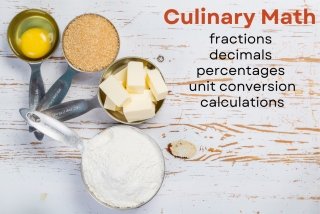
Culinary Math Teaching Series Revisited
02 October 2023Review helpful culinary math teaching techniques from a talented math culinary arts instructor.
By Lisa Parrish, GMC Editor
Feedback & comments: This email address is being protected from spambots. You need JavaScript enabled to view it.
Challenging applied math problems can baffle students who are more motivated by flavor combinations and cooking techniques than number calculations. Scaling recipes or completing a costing form rarely ranks as the number one reason to jump into foodservice.
Linda Blocker, associate professor in the School of Business and Hospitality Management at SUNY Delhi, calls this math apprehension, “general math baggage.” She understands students’ anxiety and math aversion when working with fractions, decimals, percentages and unit conversations. Many math concepts students learned prior to becoming a culinary student may not apply in the cooking environment.
Last year, Blocker wrote a series of culinary math articles for the Gold Medal Classroom describing teaching techniques designed specifically for culinary students. Topics included measurement conversions, understanding fluid ounces versus ounces, rounding errors and more.
As instructors begin teaching a new cohort of potentially math-challenged students, perhaps a math teaching technique review may be helpful.
Culinary Math Teaching Series by Linda Blocker
- Math instructor Linda Blocker shares tips on building students’ math confidence from decimals and fractions to costing out recipes. Finding the extended cost of minced garlic.
- Demystify math for students with practical teaching tips. The continuation of common errors when finding the extended cost of minced garlic.
- Rounding Reality: Foodservice reality often alters natural math rules.
- Basic Unit Conversion, Part 1: The Bridge Method offers students structured support when converting ounces, cups, tablespoons and more.
- Basic Unit Conversion, Part 2: Not all fluids measure eight ounces in one cup. Understanding a sense of weight and the difference between fluid ounces and ounces.
- Advanced Unit Conversions: A descriptive visualization of weight and volume conversion helps math-stranded students understand complex problems.
- Joe Careless Food Cost Form: Recipe costing practice has students determining and explaining incorrect answers to deepen their knowledge.
- Best Practices in Teaching Culinary Math: Steering students’ culinary math success with teaching tips like showing work and using driving analogies.
